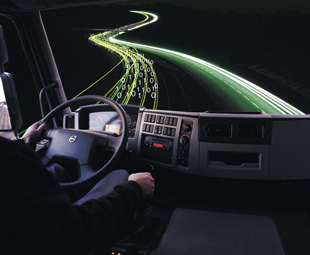Digitally speaking

Digital technologies are changing the ways in which we move around cities, towns and countries. CLAIRE RENCKEN speaks to a couple of specialists in the field about some of the latest offerings out there.
Steven Sutherland, sales director for South Africa and Africa at MiX Telematics, hits the nail on the head when he says: “The internet is taking over all facets of communication, loosely translating into the ability for data to be transferred over a network, without requiring human-to-human, or human-to-computer interaction.” Telematics service providers can be seen as early adopters of this trend.
“Telematics, in fact, integrates machines, sensors, information, software instruction and various communications technologies, facilitating real-time and long-term connectivity. The benefit of digital communication bodes well for businesses and fleet managers, allowing them to track and monitor drivers, field workers, vehicles and other mobile assets. Benefits are tangible – and bring improvements that are sustainable,” says Sutherland.
In the drive to become a digital business, fleet managers should constantly be on the lookout for tailored telematics products and services that utilise machine-to-machine technologies. “The benefits in terms of efficiency, safety, security and compliance have proved to be far-reaching. From being able to pin-point the location of vehicles and drivers, replay routes and analyse trips from anywhere in the world, and monitor driver behaviours – all via the web or mobile phones – operators are gaining more and more control. The ability for ‘big data’ to be transferred over a network requires little human interaction, and so much can be learned, understood and changed by analysing this data,” he explains.
In conjunction with efficiency goals, fleet operators are seeing the value of adopting a reliable fleet-management solution to reduce accidents and boost safety levels. “The industry is currently facing an increase in road traffic incidents. The high accident and fatality figures are placing a question mark against who’s responsible for improving the situation. Advanced digital technology is, therefore, bound to become a much-needed component in the fleet-management mix,” adds Sutherland.
By combining on-board diagnostics with tried and tested fleet management software, it is possible to record and map exactly how a fleet is performing: from the condition of each vehicle, to the way in which it is being driven, or has been driven.
“Monitoring this in realtime, as well as historically, opens up numerous opportunities to save costs, reduce risk, enhance customer service – and, essentially, strengthen your business. Data is instantly transmitted from our customers’ vehicles directly to one of our secure data centres, after which reports are generated,” he notes.
“In-cab technology also allows drivers to be alerted to their driving style errors in real-time, meaning they can rectify poor habits, which affect fuel consumption and safety. Such devices or accessories – which include the RIBAS and the MiX Rovi – monitor speed, revving, acceleration, idling and braking,” he continues.
This positive impact that telematics can have on drivers should also not be underestimated; being supported by mobile and in-cab technology can only result in a better experience for them. “Many of our customers cement their fleet management solutions with targeted driver-training programmes and incentive schemes,” says Sutherland.
Vincent Gore, CEO of Resource Tracking, agrees that the main focus of insurance telematics, over the past three years or more, has been driver scoring (or measuring the way a specific driver handles his vehicle), to better anticipate the likelihood of an accident and a claim. Driver scoring technology, also known as usage-based insurance (UBI), allows insurers to improve price policies and attract lower risk drivers.
According to Gore, “The success of UBI has convinced many insurance industry leaders of the power of telematics, especially on the underwriting side of the business. We are now taking telematics one step further into insurance claims operations, by fully automating accident reporting and analysis.”
Resource Tracking is set to mark a global first with the imminent introduction of ground-breaking crash technology that alerts local emergency services on impact. Gore says the introduction of Fully Automated Crash Technology (FACT) to the South African market will completely revolutionise how emergency services respond to accidents. “The system immediately alerts emergency services within seconds of an accident, determining the level of response required and the damage to the vehicle,” he explains.
In addition, the technology automatically and accurately predicts the possible injuries to the occupants of a vehicle, thereby providing actionable data to inform the dispatching of response teams. FACT is also able to quantify the mechanical damage to a vehicle, calculating the angle of the impact, vehicle crush, bill of materials and a preliminary cost to repair the vehicle. “Being able to provide insurance companies with a report that can calculate these factors, all in realtime, is truly cutting edge,” says Gore.
He says that several major telematics companies in South Africa have now completed technical due diligence on the technology and are entering into pilot projects. “It’s been an exciting journey to date, and we’re looking forward to working with our partners to bring this technology swiftly to the South African market.”
Gore believes that crash management technology can make a significant difference to the fatality rates as a result of road accidents.
In conclusion, Sutherland sums it up well: “When you consider the many business advantages being driven by our digital era, businesses should be willing to jump aboard. It’s almost a case of ‘now or never’ for those forward-thinking competitors who have the edge to stay ahead of the pack.”
Published by
Focus on Transport
focusmagsa




